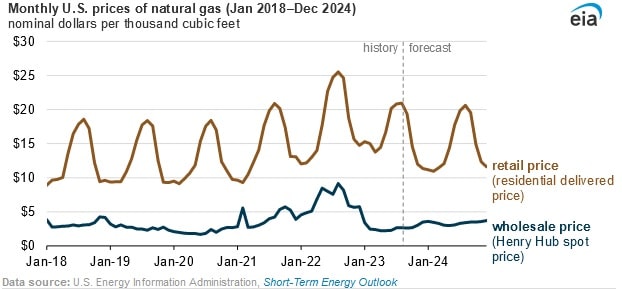Changes in U.S. Wholesale Spot Natural Gas Prices Has a Lagged Impact on Prices Paid by Residential Consumers: EIA

The monthly U.S. natural gas spot price on the U.S. benchmark Henry Hub has largely followed a downward price trend so far in 2023, however these lower wholesale gas prices are not directly being translated into lower commodity rates for residential customers, according to an Sep. 19 report from the U.S. Energy Information Administration. U.S. natural gas spot prices have declined due to a number of factors including record production, above seasonal normal temperatures that led to lower gas demand, and higher than average inventories at the end of the winter season. Despite the price decline in the wholesale market, changes in retail natural gas prices lag changes in wholesale gas prices due to utility regulation.
Residential gas prices consist of two key elements, the first being the cost of the commodity, or the costs paid to buy the wholesale natural gas. The second component is the related transportation and distribution payments.
Local distribution companies, or LDCs directly purchase the natural gas from the wholesale market to supply their residential, commercial, industrial, and electric power customers. The companies usually hedge in advance, in order to limit price risk and reduce price volatility. As a result of this risk management, the natural gas prices the distribution companies pay is the price that they hedge the commodity. Moreover, in order to limit price risk and ensure security of supply, they obtain assured transportation on pipelines and reserve storage capacity.
The state public utility commissions govern residential natural gas prices. Unit rates adjustments could lag changes in the LDC’s cost of procuring natural gas due to the obligations set by state commissions. State-regulated utility companies are usually prohibited from earning or losing money from natural gas commodity sales and as a result, distribution companies are required to modify these rates at intervals, through purchased gas adjustment charges incorporated on utility bills. Purchased gas adjustment charges differ depending on both the state and the company involved.
During extreme weather events, distribution companies may impose additional charges to utility bills. The additional cost paid for the commodity due to the extreme event, would be passed onto the consumer, once the distribution companies file motions with their state regulators. The cost is usually spread over a period of time, so that the consumers are able to manage.
EnerKnol Pulses like this one are powered by the EnerKnol Platform—the first comprehensive database for real-time energy policy tracking. Sign up for a free trial below for access to key regulatory data and deep industry insights across the energy spectrum.
ACCESS FREE TRIAL